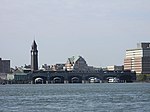Hoboken Terminal is a commuter-oriented intermodal passenger station in Hoboken, Hudson County, New Jersey. One of the New York metropolitan area's major transportation hubs, it is served by nine NJ Transit (NJT) commuter rail lines, one Metro-North Railroad line, various NJT buses and private bus lines, the Hudson–Bergen Light Rail, the Port Authority Trans Hudson (PATH) rapid transit system, and NY Waterway-operated ferries.
More than 50,000 people use the terminal daily, making it the ninth-busiest railroad station in North America and the sixth-busiest in the New York area. It is also the second-busiest railroad station in New Jersey, behind only Newark Penn Station, and its third-busiest transportation facility, after Newark Liberty International Airport and Newark Penn Station.The rail and ferry terminal buildings were constructed in 1907 by the Delaware, Lackawanna and Western Railroad a former Class 1 railroad. In 1930, Thomas Edison was at the controls for the first departure of a regular-service electric multiple unit train from Hoboken Terminal to Montclair. In 1973 the terminal building was added to the New Jersey Register of Historic Places and the National Register of Historic Places.
Hoboken Terminal is considered a milestone in American transportation development, initially combining rail, ferry, subway, streetcar and pedestrian services. Later on in time bus, and light-rail were added to the terminals as well. Another thing noted in the terminal's design is the terminal's 225-foot (69 m) clock tower. The tower was replaced by a radio tower that stood for more than half a century, until being removed in June 2006, when it was replaced with a new clock tower modeled after the original.









